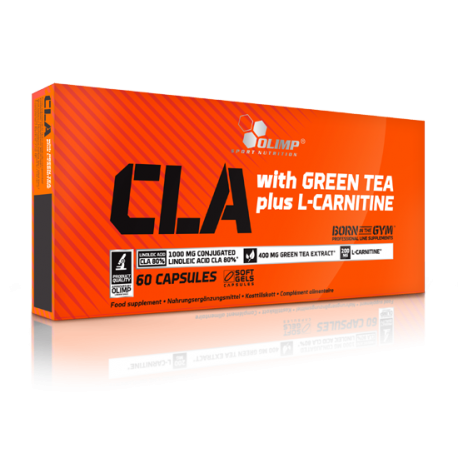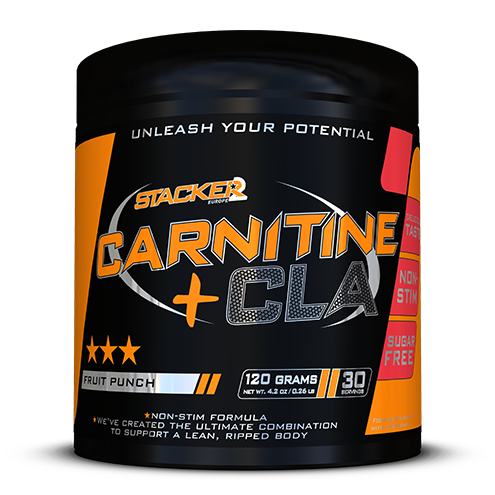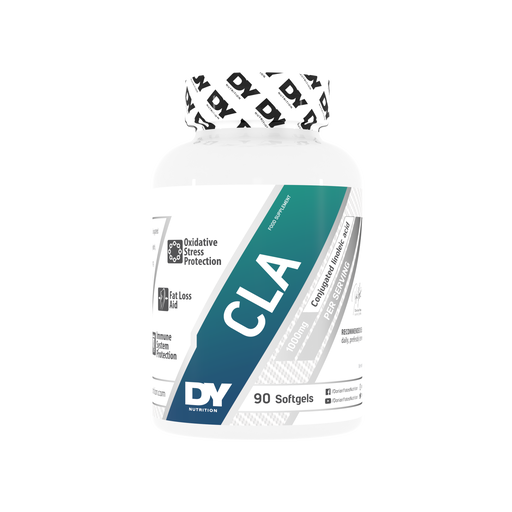CLA
-
 Jetzt 11% sparen
Jetzt % sparen
Original-Preis €24,90Original-Preis €24,90 - Original-Preis €24,90Original-Preis €24,90Aktueller Preis €22,16€22,16 - €22,16Aktueller Preis €22,16|/
Jetzt 11% sparen
Jetzt % sparen
Original-Preis €24,90Original-Preis €24,90 - Original-Preis €24,90Original-Preis €24,90Aktueller Preis €22,16€22,16 - €22,16Aktueller Preis €22,16|/CLA & Green Tea Plus L-Carnitine · 60 Kapseln
Olimp Sport NutritionNo reviewsOlimp CLA & Green Tea Plus L-Carnitine unterstützt den Fettabbau. Die Kombination von CLA, grünem Tee und L-Carnitin beschleunigt den Fettabba...
Vollständige Details anzeigenOriginal-Preis €24,90Original-Preis €24,90 - Original-Preis €24,90Original-Preis €24,90Aktueller Preis €22,16€22,16 - €22,16Aktueller Preis €22,16|/Jetzt 11% sparen Jetzt % sparen -
 Jetzt 0% sparen
Jetzt % sparen
Original-Preis €24,90 - Original-Preis €24,90Original-Preis €24,90€24,90€24,90 - €24,90Aktueller Preis €24,90|/
Jetzt 0% sparen
Jetzt % sparen
Original-Preis €24,90 - Original-Preis €24,90Original-Preis €24,90€24,90€24,90 - €24,90Aktueller Preis €24,90|/Carnitine + CLA · 120g
Stacker 22 reviewsL-Carnitin und CLA sind Schlüsselelemente im Fettsäurestoffwechsel. L-Carnitin transportiert Fettsäuren zu den Mitochondrien zur Energiegewinnung...
Vollständige Details anzeigenOriginal-Preis €24,90 - Original-Preis €24,90Original-Preis €24,90€24,90€24,90 - €24,90Aktueller Preis €24,90|/Jetzt 0% sparen Jetzt % sparen -
 Jetzt 11% sparen
Jetzt % sparen
Original-Preis €17,90Original-Preis €17,90 - Original-Preis €17,90Original-Preis €17,90Aktueller Preis €15,93€15,93 - €15,93Aktueller Preis €15,93|/
Jetzt 11% sparen
Jetzt % sparen
Original-Preis €17,90Original-Preis €17,90 - Original-Preis €17,90Original-Preis €17,90Aktueller Preis €15,93€15,93 - €15,93Aktueller Preis €15,93|/CLA · 90 Softgels
DY NutritionNo reviewsCLA unterstützt effektiv den Fettabbau und ist bewährt durch empirische Belege. Extrahiert aus Saflorpflanzen, liefert 1000mg modifizierte Omega-...
Vollständige Details anzeigenOriginal-Preis €17,90Original-Preis €17,90 - Original-Preis €17,90Original-Preis €17,90Aktueller Preis €15,93€15,93 - €15,93Aktueller Preis €15,93|/Jetzt 11% sparen Jetzt % sparen
Aufgrund ihrer einzigartigen Effekte hat konjugierte Linolensäure (CLA) eine wichtige Bedeutung beim Schutz vor chronischen Erkrankungen. Dazu zählt in erster Linie die Prävention vor malignen Krebserkrankungen und deren Progression. Darüber hinaus führt die Zufuhr von CLA mit der täglichen Nahrung auch zu einer Verminderung des Körperfettanteils. Vor einigen Jahren hat die Entdeckung von konjugierter Linolensäure ("Conjugated Linoleic Acid" - CLA) zu einer wissenschaftlichen Sensation geführt. Denn immerhin konnte für dieses Fettsäurederivat nachgewiesen werden, dass es über besonders starke Anti-Tumoreigenschaften verfügt.
Diese führten im Rahmen von Studien zu einer Hemmung bösartiger Krebserkrankungen wie Brustkrebs, Prostatatumoren, Magen-Darmkarzinomen sowie malignen Hauttumoren (z. B. Melanom). Biochemisch handelt es sich bei Linolensäure um eine essentielle Fettsäure (wie auch Arachidonsäure sowie Linolsäure), die im Organismus nicht synthetisiert werden kann und dementsprechend mit der Nahrung zugeführt werden muss. CLA ist ein etwas verändertes Derivat der Linolensäure und in großen Mengen in rotem Fleisch sowie Käse enthalten. Darüber hinaus findet sich CLA auch in Hühnerfleisch, Eiern sowie Maiskeimöl.
Ein tatsächlicher Mangel an CLA ist de facto nur schwer nachweisbar. Es gibt aber eine Reihe von Hinweisen aus wissenschaftlichen Untersuchungen, dass eine an CLA arme Diät längerfristig zur Steigerung des Körperfettanteils führt und somit einen wichtigen Faktor in der Entstehung der Fettsucht darstellen dürfte. Aufgrund einzigartiger Wirkungsmechanismen besitzt CLA eine Reihe von Effekten im Sinne einer Prävention von chronischen Erkrankungen und hat auch einen positiven Einfluss auf die Körperfettreduktion. Aus diesem Grund ist CLA mittlerweile als Nahrungsergänzungsstoff verfügbar.
Bei CLA handelt es sich um ein wirkungsvolles Antioxidans, das darüber hinaus antikarzinogene sowie antikatabole Effekte besitzt. Weiters wirkt CLA als potenter Stimulator auf das Immunsystem des Körpers, was für die präventiven Eigenschaften von CLA in Bezug auf die Krebsentstehung, -entwicklung und -progression verantwortlich sein dürfte. Diese Wirkungen von CLA wurden in zahlreichen wissenschaftlichen Untersuchungen entdeckt und beschrieben. Die Zufuhr von CLA mit der täglichen Nahrung bzw. als Nahrungsergänzungsstoff führt zu einer Verminderung des Verhältnisses zwischen reiner Körpermasse und dem Körperfettanteil. Weiters kommt es zu einer geringeren Fettdeposition im Bereich des Abdomens, und CLA führt auch zu einer Verstärkung der Muskelbildung.
Physiologisch kommen diese Effekte durch eine Verstärkung der Insulinsensitivität im peripheren Gewebe zustande, sodass freie Fettsäuren und Glukose speziell der Muskulatur rascher zur Verfügung gestellt werden können und nicht im Fettgewebe gespeichert werden. Im Hinblick auf die antikatabolen Effekte ist diese Eigenschaft von CLA insbesondere auf eine Prävention des Abbaus von Muskelgewebe zurückzuführen. Im Vergleich zu früheren Generationen konnte speziell bei der US-amerikanischen Bevölkerung festgestellt werden, dass es zu einer relativen Defizienz von CLA in der täglichen Ernährung gekommen ist. Dies ist vor allem auf eine Änderung der Fütterung von Weidevieh zurückzuführen, wodurch der CLA-Gehalt in Milch sowie Milchprodukten gesunken ist.
Denn für eine optimale CLA-Produktion benötigen Kühe frisches Grasfutter, was bei der heute üblichen Massentierhaltung oft unmöglich gemacht wird. Dieser CLA-Mangel dürfte z.T. auch für die epidemische Fettsucht, die in Amerika um sich greift, verantwortlich sein. Schlechte Ernährungsgewohnheiten sowie auch ein Mangel von CLA in den Nahrungsmitteln haben weit reichende Auswirkungen auf Gesundheit und Langlebigkeit. Wegen ihrer einzigartigen Effekte auf Immunsystem und Stoffwechsel sollte CLA daher einen wichtigen Baustein in jedem ausgewogenen Nahrungsergänzungsprogramm darstellen.
Insbesondere konnten für CLA die folgenden aktiven Eigenschaften bzw. Wirkungen nachgewiesen werden: Hemmung des Wachstums maligner Tumorerkrankungen - Verbesserung der Funktion des Immunsystems - Steigerung der Insulinsensitivität im peripheren Gewebe - Antikatabole Effekte in Bezug auf die Muskulatur - Verminderung der Fettspeicherung - Steigerung der Körpermasse im Verhältnis zum Körperfett - Cholesterinsenkung und antiatherogene Effekte - antioxidative Eigenschaften Schutz vor Osteoporose.
Sicherheit und Nebenwirkungen
Konjugierte Linolsäure ist bei einer Verwendung in lebensmittelüblichen Mengen wahrscheinlich sicher und bei einer Verwendung in höheren, medizinischen Mengen möglicherweise sicher und unbedenklich. Mögliche Nebenwirkungen umfassen Magenverstimmungen, Durchfall, Übelkeit und Müdigkeit.
Vorsichtsmaßnahmen und Warnungen
Schwangerschaft und Stillzeit: Es ist nicht genug über die Sicherheit von konjugierter Linolsäure während Schwangerschaft und Stillzeit bekannt. Aus diesem Grund sollten schwangere und stillende Frauen sicherheitshalber auf konjugierte Linolsäure verzichten. Diabetes: Es gibt Bedenken, dass konjugierte Linolsäure eine bestehende Diabetes verschlimmern könnte. Metabolisches Syndrom: Es gibt Bedenken, dass konjugierte Linolsäure das Risiko für eine Entwicklung von Diabetes bei Menschen, die unter dem metabolischen Syndrom leiden, erhöhen könnte. Aus diesem Grund sollte man konjugierte Linolsäure nicht verwenden, wenn man unter dieser Störung leidet.
Optimale Dosierung im Sport
Diätetische Maßnahmen mit Einschränkung der täglichen Energiezufuhr, mit sportlicher Betätigung, ist bei Übergewichtigen die Therapie der Wahl. Kohlenhydratarme Diäten haben sich dabei gegenüber fettarmen Diäten als überlegen erwiesen. Konjugierte Linolsäure kann über metabolische Effekte die Körperzusammensetzung der Magermasse beeinflussen und letztlich auch gewichtsreduzierend wirken. Meine Empfehlung ist eine Tägliche zufuhr von 3-5g zu den Mahlzeiten. Allerdings müsste man über die Nahrungsmittel kiloweise verzehren, um auf eine nennenswerte Zufuhr von CLA, die im diesen Bereich (3-5g)pro Tag liegt, zu kommen. Eine Nahrungsergänzung wäre deshalb zu empfehlen.
Referenzen
- Larsen TM, Toubro S, Astrup A. Efficacy and safety of dietary supplements containing conjugated linoleic acid (CLA) for the treatment of obesity-evidence from animal and human studies. J Lipid Res. 2003 Aug 16 [Epub ahead of print].
- Belury MA. Dietary conjugated linoleic acid in health: physiological effects and mechanisms of action. Annu Rev Nutr. 2002;22:505-31. Epub 2002 Apr 04.
- Banni S. Conjugated linoleic acid metabolism. Curr Opin Lipidol. 2002 Jun;13(3):261-6.
- Kelly GS. Conjugated linoleic acid: a review. Altern Med Rev. 2001 Aug;6(4):367-82.
- Pariza MW, Park Y, Cook ME. Conjugated linoleic acid and the control of cancer and obesity. Toxicol Sci. 1999 Dec;52(2 Suppl):107-10.
- Miner JL, Cederberg CA, Nielsen MK, Chen X, Baile CA. Conjugated linoleic acid (CLA), body fat, and apoptosis. Obes Res. 2001 Feb;9(2):129-34.
- Oku H, Wongtangtintharn S, Iwasaki H, Toda T. Conjugated linoleic acid (CLA) inhibits fatty acid synthetase activity in vitro. Biosci Biotechnol Biochem. 2003 Jul;67(7):1584-6.
- Kilian M, Mautsch I, Gregor JI, Heinichen D, Jacobi CA, Schimke I, Guski H, Muller JM, Wenger FA. Influence of conjugated and conventional linoleic acid on tumor growth and lipid peroxidation in pancreatic adenocarcinoma in hamster. Prostaglandins Leukot Essent Fatty Acids. 2003 Jul;69(1):67-72.
- Chen BQ, Yang YM, Gao YH, Liu JR, Xue YB, Wang XL, Zheng YM, Zhang JS, Liu RH. Inhibitory effects of c9, t11-conjugated linoleic acid on invasion of human gastric carcinoma cell line SGC-7901. World J Gastroenterol. 2003 Sep;9(9):1909-14.
- Belury MA. Inhibition of carcinogenesis by conjugated linoleic acid: potential mechanisms of action. J Nutr. 2002 Oct;132(10):2995-8.
- Nagao K, Inoue N, Wang YM, Hirata J, Shimada Y, Nagao T, Matsui T, Yanagita T. The 10trans,12cis isomer of conjugated linoleic acid suppresses the development of hypertension in Otsuka Long-Evans Tokushima fatty rats. Biochem Biophys Res Commun. 2003 Jun 20;306(1):134-8.
- Noone EJ, Roche HM, Nugent AP, Gibney MJ. The effect of dietary supplementation using isomeric blends of conjugated linoleic acid on lipid metabolism in healthy human subjects. Br J Nutr. 2002 Sep;88(3):243-51.
- Riserus U, Arner P, Brismar K, Vessby B. Treatment with dietary trans10cis12 conjugated linoleic acid causes isomer-specific insulin resistance in obese men with the metabolic syndrome. Diabetes Care. 2002 Sep;25(9):1516-21.
- Watkins BA, Seifert MF. Conjugated linoleic acid and bone biology. J Am Coll Nutr. 2000 Aug;19(4):478S-486S.
- Albers R, van der Wielen RP, Brink EJ, Hendriks HF, Dorovska-Taran VN, Mohede IC. Effects of cis-9, trans-11 and trans-10, cis-12 conjugated linoleic acid (CLA) isomers on immune function in healthy men. Eur J Clin Nutr. 2003 Apr;57(4):595-603.
- Basu S, Riserus U, Turpeinen A, Vessby B. Conjugated linoleic acid induces lipid peroxidation in men with abdominal obesity. Clin Sci (Lond). 2000 Dec;99(6):511-6.
- Smedman A, Vessby B, Basu S. Isomer specific effects of conjugated linoleic acid on lipid peroxidation in humans. Regulation by Alpha Tocopherol and Cyclooxygenase-2 inhibitor. Clin Sci (Lond). 2003 Sep 4 [Epub ahead of print].
- Degrace P, Demizieux L, Gresti J, Chardigny JM, Sebedio JL, Clouet P. Association of liver steatosis with lipid oversecretion and hypotriglyceridaemia in C57BL/6j mice fed trans-10,cis-12-linoleic acid. FEBS Lett. 2003 Jul 10;546(2-3):335-9.



